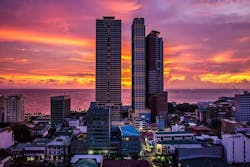Resilience, sustainability emphasized in plans for new 23,000-acre city in the Philippines
By Peter Fabris, Contributing Editor
Resilience to natural disasters and sustainability are guiding planning for a new 23,350-acre city on the site of Clark Air Base in the Philippines.
The Philippines, vulnerable to typhoons and earthquakes among other calamities, is one of the most disaster-prone places on Earth. Resiliency for the new city, expected to eventually house 1.2 million people, begins with its location where the lowest point will be more than 177 feet above sea level.
Only a third of the city’s land will be developed—the rest reserved for green spaces and agriculture, which will improve drainage and reduce flooding. Development will be sited away from earthquake fault lines. Developers will use concrete mixed with a local organic building material that will withstand shaking better than conventional concrete.
The city will be pedestrian-friendly with efficient mass transportation. One commentator remarked that “the right metaphor for Clark is iCloud—a backup for when Manila fails.” The development is expected to take 25 to 30 years to complete.
